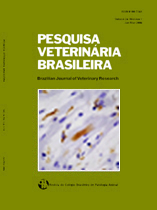 |
|
|
|
Year 2007 - Volume 27, Number 10
|

|
Identificação e diferenciação de herpesvírus bovino tipos 1 e 5 isolados de amostras clínicas no Centro-Sul do Brasil, Argentina e Uruguai (1987-2006), p.403-408
|
ABSTRACT.- Silva M.S., Brum M.C.S., Weiblen R. & Flores E.F. 2007. [Identification and differentiation of herpesvirus types 1 and 5 isolated from clinical samples in central-southern Brazil, Argentina and Uruguay (1987-2006).] Identificação e diferenciação de herpesvírus bovino tipos 1 e 5 isolados de amostras clínicas no Centro-Sul do Brasil, Argentina e Uruguai (1987-2006). Pesquisa Veterinária Brasileira 27(10):403-408. Departamento de Medicina Veterinária Preventiva, Universidade Federal de Santa Maria, 97105-900 Santa Maria, RS, Brazil. E-mail: flores@ccr.ufsm.br
Bovine herpesviruses types 1 and 5 (BoHV-1; BoHV-5) are genetically and antigenically closely related such they can not be distinguished by routine diagnostic tests. As BoHV-1 has been historically associated with respiratory and genital disease, herpesviruses isolated from these clinical syndromes have been tentatively – and sometimes definitively - diagnosed as BoHV-1. Likewise, cases of herpetic neurological infection in cattle have been generally attributed to BoHV-5. This study reports the identification of 40 herpesvirus isolates from different clinical specimens and syndromes in central-southern Brazil, Argentina and Uruguay (1987-2006) by the use of a PCR able to differentiate between BoHV-1 and BoHV-5. BoHV-1 isolates (n=16) were identified in cases of respiratory disease (n=3), vulvovaginitis and/or balanoposthitis (n=3), in semen of healthy bulls (n=5) and in cases of neurological disease (n=5). Viruses identified as BoHV-5 (n=24) were isolated predominantly from cases of neurological disease (n=21), but also from semen of healthy bulls (n=2) and from a spleen of a calf with systemic disease (n=1). These results show that both BoHV-1 and BoHV-5 are not strictly associated with their respective diseases; yet are frequently involved in clinical conditions otherwise attributed to the other virus. These findings also reinforce the need of correctly identifying the herpesvirus isolates as to better understand their pathogenesis and epidemiology. |
| |
|
|
| |
|
 |